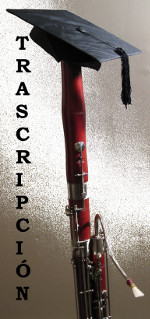Weissenborn Opus 8/2, Study #16 for advanced bassoon students. More examples of practicing with rhythms and sprints. Bach's Bible. Guest performer Martha Schulenburg. By Terry B. Ewell, Bassoon Digital Professor. BDP#124. www.2reed.net.
Weissenborn Opus 8/2, Estudio Avanzado #16. Más ejemplos practicando con ritmos y sprints. La Biblia de Bach. Intérprete invitado: Martha Schulenburg. Por Terry B. Ewell, Profesor Digital de Fagot. Traducido por Germán Martínez López. BDP #124. www.2reed.net
TUTORIAL
1. Welcome, this is Terry Ewell. Study #16 stresses excellent
finger
work. The sixteenth note runs should be fluid and with even finger
motions. Fast moving 16th notes are best mastered with rhythms that
emphasize multiple quick notes. The dotted rhythms, for instance, will
not help us to master this study well.
1. Bienvenidos, soy Terry Ewell. El estudio #16 fomenta un
excelente
trabajo de dedos. Las cadenas de semicorcheas deben ser fluidas, con un
movimiento regular de los dedos. Los movimientos rápidos de
semicorcheas se consiguen mejor con ritmos que afecten a muchas notas
rápidas. Los ritmos con puntillo, por ejemplo, no nos
ayudarían a dominar bien este estudio.

2. Rather, rhythms of eighth notes with triplet sixteenths are
much
better because they force the fingers to move rapidly through groups of
notes.
2. En su lugar, ritmos de corcheas con tresillos de
semicorcheas son
mucho mejores porque fuerzan los dedos a moverse rápidamente
a
lo largo de grupos de notas.


3. Sprints are another excellent way to master the study. In
fact,
this is the best practice method to use in this study. Line 5 in the
study, for instance, presents some difficult finger combinations. Here
is a sequence of sprints to practice for the first measure. Practice
each sprint until you have mastered it in a tempo faster than what you
will need to perform. Notice that I start from the end of the section
and add more notes working backwards in the music.
3. Los
sprints son otra buena forma de hacerse
con el estudio. De hecho, este es el mejor método para
practicar este estudio.
La línea 5 del estudio, por ejemplo, presenta algunas
combinaciones de
difíciles de dedos. Aquí tenéis una
secuencia de sprints para practicar el
primer compás. Practicad cada sprint hasta que lo
hayáis dominado a un tempo
más rápido de lo que vayáis a tocarlo.
Fijáos en que empiezo en el final de la
sección y, poco a poco, voy añadiendo notas que
estaban anteriormente.




4. This type of practice should be done for each measure in
the
line. Finally then connect the measures so that you have the whole line
mastered.
4.Este
tipo de práctica debería hacerse con
cada compás de la línea, Finalmente, conectad los
compases hasta que tengáis la
línea completa dominada.
5. Of course you will need to use the flick keys for the slurs to Bb3
and D4 in line 8.
5.Por
supuesto, necesitaréis usar las llaves
de octava para las ligaduras a Sib3 y Re4 en la línea 8.

6. If you are unable to play the passage in lines 6-8 in one breath, I have suggested breaths at the beginning of lines 7 and 8. Neither of these breaths is ideal, however, since breathing there will delay the downbeats.
6.Si no podéis tocar el pasaje de las líneas 6 a la 8 con una sola respiración, os he indicado algunas sugerencias para respirar al principio de las líneas 7 y 8. Sin embargo, ninguna de estas respiraciones es ideal, ya que respirar ahí retrasaría la caída al siguiente compás.
REFLECTION REFLEXIÓN
Soli Deo Gloria (To the Glory of God Alone)
7. Weissenborn indicated his faith in God with his selection
of the
hymn tune in his Trio. Johann Sebastian Bach provided evidence of his
faith in almost every musical work he wrote. He wrote the initials "S.
D. G." at the end of all his church compositions and many of his
secular works. This is an abbreviation for Soli Deo Gloria,
a Latin phrase that means “to the glory of God
alone.”
7.
Weissenborn indicó su fe en Dios con su elección
de la melodía del himno en su
Trio. Johann Sebastian Bach dio evidencia de su fe en casi todas las
obras
musicales que escribió.
Él escribió las
iniciales “S.D.G.” al final de todas sus
composiciones para iglesia y muchas de
sus obras seculares. Esta es una abreviación de Soli Deo Gloria, una
frase en
latín que significa “Solo a Dios sea la
Gloria.”
8. Bach didn’t just express his faith in public, there were many examples of his private devotion to God as well. One of my prized books is a copy of pages from Bach’s Bible. In the Bible are his underlinings, comments, and margin notes. Despite his very busy work schedule and the demands of a large family, Bach still made time to read the Bible. His notes in this book show his devotion to learning more about God.
8. Bach no solamente expresó su fe en público, también hubieron muchos ejemplos de su devoción a Dios en privado. Uno de mis libros preciados es una copia de las páginas de la Biblia de Bach. En esta Biblia están sus subrayados, comentarios, y notas de margen. A pesar de su ocupado calendario de trabajo y las demandas de una familia numerosa, Bach aún tenía tiempo de leer la Biblia. Sus anotaciones muestran su devoción por aprender más acerca de Dios.
CREDITS CREDITOS
Bach_SDG_confirmed.jpg
http://www.dw.de/new-bach-discovery-raises-question-of-burn-out/a-17326653
References: Referencias:
Howard H. Cox, ed., The Calov Bible of J. S. Bach,
(Ann Arbor: UMI Research Press, 1985)
Patrick Kavanaugh, The Spiritual Lives of Great Composers (Nashville,
Sparrow Press, 1992).
https://en.wikipedia.org/wiki/Soli_Deo_gloria
